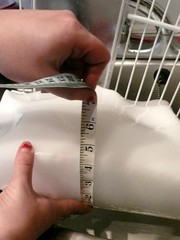Central Station: the transport hub of the city. Trams and metro to all parts of the city; buses to all parts of the suburbs. Ferries to get you across the harbour. And trains, of course, to the airport, to the rest of the country, to the rest of Europe. Underneath the station a crisscross of subways provides the usual transport-hub range of things a traveller in need might be looking for. New luggage, flowers, quick food. There are fast food units in the subway, selling chips, fried chicken in a bun, other forms of quickly-cooked meat, where the shy but hungry traveller need not even speak to the staff; and conversely a shy fast-food-frier never need speak to their customers. The whole front of the unit is a wall of clear plastic coin-operated boxes, each with a door at the front and a door at the back, each hopefully containing some tasty but unhealthy morsel. The hungry traveller puts their coins in the slot and opens the box; at the back, the staff fill up empty boxes with more hot food. Everything is, under heat lamps, on display behind its little perspex door to tempt you.
We didn’t, I have to admit, arrive in Amsterdam by train. We arrived on the cheap overnight bus from London, which drops you off first thing in the morning in a car park on an artificial island in the harbour, midway between the city and the equally artificial suburb of IJburg. The tram then takes you onwards into the city, tunnelling under the Amsterdam-Rhine Canal, backpackers and budget tourists packed in alongside commuters on their way to work. It takes you, naturally, to the vortex of looping tram tracks and platforms in the forecourt of Central Station. We changed trams to head off to our hotel, stood waiting for our next tram to arrive, and took in the sounds of the city.
The main entrance of the Central Station has a clock tower at either end, square, topped with a pyramidal spire. On the right-hand tower is a clock face. The left-hand tower has something that at first sight looks similar, but with only one hand On the day we arrived the single golden hand was sweeping back and forth rapidly, with no apparent pattern to its movements. Bells were clanging, and I thought through some natural pattern-seeking train of thought, that each clang of a bell corresponded with the swish of the single hand through each segment of its face. It was an auditory illusion: the bells were the bells of trams pulling away from their stops, a sound you will hear all over the city. After a few minutes I realised that the markings on the face - N, NO, O, ZO, Z and so on - were the Dutch compass points. The hand was a wind indicator, connected mechanically to the weathervane atop its tower, responding to the gusty wind blowing across the flat waters and flatter land surrounding the city, telling everyone with the skill to read it which boats they might expect to be coming into harbour from which directions, and which might find the weather fit to sail. A suitable sign for a merchant city whose golden days were created by sailing ships gone for months at a time, where the traders left back at home would carefully watch the wind, wary of whether it would indicate fantastic profit or total ruination.
It is, of course, fake. Almost brazen in its fakery. I don’t mean that it doesn’t do anything, that there’s no weathervane and the hand’s movements are random: it is genuinely displaying what the wind is doing above Amsterdam right now. What is fake about it, is the thought that any merchants ever watched this particular weathervane for signs that their fortune was about to be lost or made. Central Station wasn’t built until the 1880s, and it was built on Station Island, which as the name suggests didn’t exist until it was needed to put the station on. Station Island was dropped right across the old harbour mouth, roughly on the spot where, back in the city’s golden days, a floating boom was laid out every night to defend against attack from the water. The Central Station sealed off the old quaysides along the River Amstel, the source of the city’s wealth, from the wilder waters of the IJ. It was controversial; it was the final death-blow to the old, decaying Golden Age city’s harbour. The wind indicator on top of the station is, in some ways, the first sign of tourist theme-park Amsterdam. Telling all those waiting for their trams that today the winds are good for boats at anchor in the Zuider Zee to come into port and land their precious cargo, even though the building it is part of would fox any attempt by a temporally-adrift East India boat to reach the city’s merchant quays. For that matter the Zuider Zee itself is no more: the IJ, the bay that Amsterdam teetered on the edge of, is a freshwater inlet of the Markermeer lake, one of several different and separate patches of water and land which the old, treacherous Zuider Zee was carved into during the twentieth century.
Only a few minutes’ walk from the station, the Oude Zijde is the real tourist heart of the city. And by that, I mean, tourists flocking to Amsterdam will generally reach Central Station and pour themselves into the Oude Zijde to get drunk, get stoned, and have sex. By “tourists” I mean a particular type of tourist, of course, largely young alcoholic men, and by “have sex” I mean mindless mechanical fucking. I might not know the city well, but the Oude Zijde seems to be constantly crammed with drunken tourists staggering about, gawping at the fetish shops as they wander from bar to bar, joking about how many whores they’re going to use, should they find the courage. The brothels themselves are unmissable: shop frontages consisting solely of glass doors, pink neon strip-lights above them. Behind each door stands a woman in cheap satin underwear, posing for the passing drunkards to try to entice them in. Should one of them have enough courage - each, I imagine, thinking of the amount of “banter” he will get from it back home in Corby or Hexham or Andover as long as nobody tells his fiancé about it - the woman will take their cash and lead them through the door, upstairs into a tiny bedroom, leaving her doorway empty until she is ready for the next fucking customer. Then she comes back to present herself on show again, like a bag of chips, or some fried chicken in a bun. “I can’t believe you did it, mate,” the customer’s friends will shout, all too willing to believe that women will.
I don’t like to think that the Oude Zijde, popular though it is with all the tourists, represents the real Amsterdam. It horrified us. Some streets in Britain have a bad reputation on a Saturday night: St Marys Street in Cardiff, for example, or the Centre in Bristol. The Zeedijk of the Oude Zijde, though, was hardly any more pleasant than a British city Saturday night, on a summer weekday afternoon. When I think back about Amsterdam, I try to block the Oude Zijde, its endless vomit-bars and its women-as-fast-food out of my mind. We never even tried to see any of its great sights, such as the church which gives the district its name.
Walk, instead, in the other direction. Start, again, looking at cheap food beneath Central Station; but walk the other way, through the tunnels under the station platforms, under the bus station, and on to the banks of the IJ. At one time you would have been looking out on open water; swimming in it, in fact, before Station Island was built. Nowadays it seems more like a river, a Thames or a Hudson, but back in time this was a wide bay. The water, whatever you call it, is busy here, with little boats darting back and forth; free ferries linking North Amsterdam with the main part of the city, and longer-distance boats slowly ambling past them. “Upstream” and “Downstream” are meaningless concepts on this stretch of carefully-managed water. Originally the way to the sea lay east, via what is now the Markermeer and the IJsselmeer; then, after a canal was dug, north; nowadays west via the newer, larger North Sea Canal.
I’ve never really been to sea, other than the occasional ferry. The longest I’ve spent on a boat, as far as I can remember, is on the cross-channel ferry from Dover to Dunkirk, an entire two hours spent steaming across the mad dash that is the Strait of Dover, dodging heavily-loaded container ships heading from China to Rotterdam. According to my mother though, a hundred and fifty years back our family consisted of a tight-knit bunch of Cornish fishermen and wreckers living in a village so nautical it didn’t even have road access. Before that, according to family myth, the Cornish fishermen had in turn descended from a group of Spaniards who decided to switch sides in 1588 and never made it home again. However implausible this story might be, however unlikely it is that I could inherit tastes specifically from a branch of my ancestry that can only make up, at the most, a sixteenth part of my genetic heritage, I have to admit that I do rather enjoy the abstract concept of being in a boat. In, I promise, an entirely armchair way. I love to walk alongside a harbour watching canoeists capsize and trainee sailors send their sailboats in the wrong direction, and think it might be nice to try it out, some time in the future. The one time I did actually try canoeing, back in primary school, I was the only child in the entire class to fall in, so it’s probably a good idea if this theoretical aptitude remains completely hypothetical. Nevertheless, getting on board one of the ferries that run back and forth across the IJ, hand resting on the side of the boat, looking out across the choppy water studded with red buoys, I certainly felt in my element. The boats are simple straightforward things, symmetrical, both bow and stern consisting of a large fold-down gangway via which pedestrians, cyclists, scooters and tuk-tuks all pour aboard; the passenger deck runs straight through from end to end, with the bridge up above in the centre, the boats shuttling back and forth from one bank of the IJ to the other without ever needing to turn around. When they get going, they get going with a purpose, forcefully pushing their way blunt-ended across the water or up and down the harbour, past warehouses turned into flats and shipyards turned into offices. The working docks are now east along the canal towards the sea, so large on the map they dwarf the city itself.
Over on the far side of the IJ, we found a café which seemed put together from random timbers and pieces of plastic panelling, sitting on a point overlooking the water. Tucked away behind it was a sty, to raise its own pork and bacon. We sat indoors and relaxed as rain battered the windows, surrounded by dereliction repurposed for offices and street art. The stumps of shipbuilding cranes still stood, sawn off abruptly at their hips: it had a disconcerting effect, as if their upper parts had been Photoshopped out of the scene. This redeveloped dockland was nothing at all like the hard, shiny, corporate enclaves of Canary Wharf; instead, it was if the residents of Stokes Croft or Shoreditch had suddenly been teleported to some derelict post-industrial wasteland and left to get on with things. We don’t seem to do redevelopment like that in Britain. If you visit somewhere with partly-redeveloped docksides - Cardiff Bay, say - you see a complete and severe dichotomy between entirely rebuilt landscapes filled with expensive and privately-guarded flats, and over the fence, a scene of empty desolation where the remaining port tries to hang on to docks that might, maybe, be required for trade again one day. In North Amsterdam the two blur together. Just like how, throughout Dutch history, the marshy land has blurred into the reedy inland seas.
We decided to try walking along the waterside to a different ferry terminal, the one directly opposite the Central Station, but the banks of the IJ are so indented with canals and dockland that it turned into a very long way around, compared to the direct route along the water. All of this land is unreal: instead of docks being cut into the land, land was dredged up and squeezed between the piles to form docks in the negative space. Perversely, it reminded me of growing up in Lincolnshire, in another town where the ships are higher than the buildings and modern housing estates give way to industrial sheds. We crossed a canal packed with houseboats, passed a vast, humming electrical substation, and decided to wait for the bus instead. I can imagine myself living in North Amsterdam, in a little suburban idyll only a quick bike ride from the ferry into town. Normally I think of myself as a city person, and as I said, I can’t stand the centre of Amsterdam, but I can imagine myself being entirely happy just outside. Does that make me a hypocrite?
Out in the suburbs, even in the fashionable inner suburbs where tradesmen’s tenements have been converted into designer boutiques and vegetarian restaurants, it’s easy to forget about the nasty Amsterdam that the stag parties head straight for and stay with. We tried to stick to the quiet parts of the city; we’re quiet people. Even heading out away from the centre, though, we couldn’t help noticing more of the glass-door brothels: on the edge of the Pijp district, for example, overlooking the Boerenwetering canal. You can spot them from a distance, by the distinctive pink strip-light over each door. It seemed to be the largest we’d noticed in the city to date, and we had to turn ourselves away.
You could easily accuse me of being dismissive over this, I guess, or of brushing over these Empowered Women’s right to sell their bodies and their sexuality to anyone they choose to. And I admit: I have never met any Amsterdam prostitutes, still less, to the best of my knowledge, talked to any. I have no idea what their stories are, where they came from and why they are behind their little glass door. Why shouldn’t men be able to buy sex in exactly the same way they buy a chicken burger? What harm is being done? And it’s true that the lot of an Amsterdam prosititute is, in most cases, nowhere as near as it is in those parts of Britain where prostitutes are regularly murdered by serial killers the police are usually uninterested in catching. But why should I not find it distasteful and horrific, that these women are being advertised and commoditised like this? How many end up chewed up like food? It’s a continuum, you could say: at one end there’s don’t touch performance, strippers and burlesquers showing their bodies off; in the middle you have the dominatrixes; next to them, the prostitutes. If burlesque dancers and dominatrixes are intelligent, modern, empowered and independent women using their own confidence to turn the system upside down and take advantage of the patriarchy, why doesn’t that apply to prostitutes too? To which I reply: show me a burlesque audience there to admire a woman’s empowerment and not her tits. Show me a dominatrix who dresses for herself and not for her customers. Tell me that putting a person on display behind a glass door isn’t degrading and inhumane.
I’ve read accusations charging the Dutch, or the Amsterdammers at any rate, with hypocrisy for features like the wind indicator atop Central Station. Features like tne Nieuwmarkt metro station, whose architecture commemorates the riotous protests against its own construction. But would these accusers prefer it if history and controversy was completely forgotten? It strikes me more to be a manifestation of, what we could call if we were to descend into national stereotyping, the traditional Dutch compromise. The habit which supposedly arises from the need of the medieval Dutch to agree quickly on how to fund and build each dyke, before the waters submerged them. We must build the railway across the harbour-mouth, but the railway we build will hark back to our great seafaring days. We must knock down the neighbourhood to build this metro, but we will memorialise it when we design the station. There could, you could argue, be a similar degree of pragmatism at work in the open brothels of Amsterdam. No nation on Earth, after all, has been able to ban prostitution; so put it out in the open where it can be seen. Maybe the problem I have, the revulsion I felt, is not with the brothels themselves as much as the men who flock from around the world to use them.
On a different day, as we again found ourselves walking through Stationsplein towards the city, some passing tourists with Geordie accents asked us if we knew the time. They were I assume fresh off the train from Schipol, and were astounded to discover that we, the first people they’d spoken to in the city, spoke English. I couldn’t help thinking, they should have been more surprised if we hadn’t understood them. Shortly after we came home, I received an email, one of the standard “would you like to apply for this job?” fishing emails that recruitment consultants send out in their thousands every day. This one, though, was for a job back in Amsterdam, and it promised hard that I wouldn’t need to speak a single word of Dutch. It was sorely tempting. Find ourselves a flat in a quiet part of North Amsterdam and catch the ferry to work every day. Follow all the old Dutch customs, like eating waffles and paying in cash at the supermarket. But would I really not need a single word of the language? Tempting as it was, I didn’t follow it up. Maybe nowadays, after a little reflection, I would do. Maybe I could turn a blind eye to all the tourists drawn like magnets to the Oude Zijde, and teach my children that the women displaying their bodies have nothing, but the men drawn towards them, have everything, to be ashamed of.
In case you were wondering, I did, whilst we were in Amsterdam, try out some fried chicken in a bun from a little perspex box in the subway beneath Central Station. It wasn’t the best street food I’ve ever eaten - that has to be an angelic and heavensent hot dog in Copenhagen - but it wasn’t bad either. It had all the magic ingredients that the best Western street food should always have: hot, slightly salty, slightly greasy, a deep-seated feeling of pleasurable guilt, and instant satisfaction followed ten minutes later by the knowledge that you need another. I did not, in case you were wondering where this was leading, try out any of the other clear doors. I’m not sure I will ever be comfortable that they exist, and I can’t entirely put my finger on why. I could quite happily spend all day riding a ferryboat back and forth on the IJ, watching the boats and warehouses zip past as we headed towards the glittering recumbent shell of Central Station, so long as I could block the drunken hordes from my mind. Instead, hold a wet finger in the air, feel the wind blowing across the flat, flat lands of Holland and realise what it means for fishermen in the middle of the IJsselmeer or tall ships out in the wild open sea beyond the dune-belt. I could live here, if I ever learned to compromise.
Keyword noise: holiday, travel, Amsterdam, Netherlands, Nederland, Holland, Noord Holland.

 Home
Home






